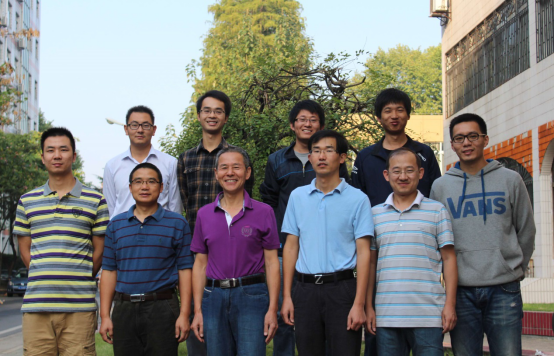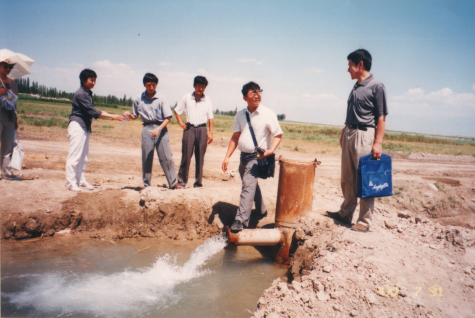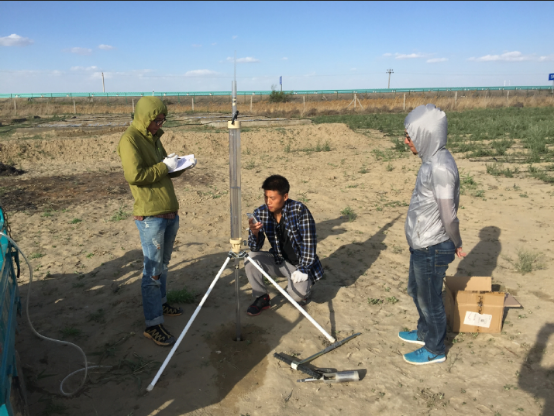There is a team from the School of Environmental Studies, which focuses on groundwater and ecological environment in arid area, has been working in Xinjiang for 20 years. Overcoming the difficulties of time, space, climate, diet, etc., they provide technical support for efficient use of water resources of different types of water quality, improvement of living standard, and sustainable development of agriculture and ecological environment in Xinjiang. Their hard work over the past 20 years contributes to the significant social and economic benefits in Xinjiang, a typical arid and semi-arid area.
Respond to the call of the state and go where they are most needed

Some of the team members in 2013
Xinjiang is located in the northwest of China and central Eurasia. It is the top priority of China’s Western Development Strategy. Xinjiang has a vast area which accounts for one-sixth of China’s territory. A total of 47 ethnic groups reside Xinjiang. Therefore, the sustainable development and ecological environment protection of Xinjiang are directly related to the overall development of China.
The precipitation and water resources in Xinjiang are very scarce and unevenly distributed, and the wide Gobi desert means ecological fragility. Since China’s Reform and Opening-up, the excessive exploitation of water and land resources as well as the unreasonable use of water resources, has led to increasingly serious environmental problems such as land desertification, secondary salinization, deterioration of surface water and groundwater, and ecological environment degradation. How to make use of water resources to develop social economy without deteriorating the ecological environment is a challenge to the coordinated development of regional economy. Determined to rise to the challenge, the team led by Prof. JIN Menggui started to work in Xinjiang in 1999.
The team mainly studies the hydrological cycle, the law of salt migration and its ecological environment effects, water resources evaluation and rational development and utilization, water-saving irrigation, and salt water utilization and regulation.

Prof. JIN Menggui ( first person on the right), CHEN Gang (second person on the right), and others were investigating in Yanqi Basin in 2000
Make breakthroughs in key technologies
The team systematically analyzed the hydrological cycle and water salt transport law at different scales (plants, cross section, fields to watersheds or basins) in the arid intra-flow basins by various approaches. They obtained new patterns of local hydrological cycle and different hierarchy of water-salt transport, which laid the foundation for the effective use of water resources.
Based on isotope technology, the team identified the moisture source of typical crops in Xinjiang, and revealed the law of waterand salt migration. The team also explored the synergetic and antagonistic mechanisms of crop growth using mulched drip irrigation with brackish water, and identified the migration and equilibrium of water and salt at the scales of fields, lakes, watersheds and regions under the natural and irrigation drainage conditions. As a result, they systematically clarified the combined effects of the hydrological cycle and salt migration in Xinjiang on the human development and ecological environment under the natural and man-made influence.
Based on a large number of field survey data and theoretical researches, the team put forward the strategies and measures for the coordinated control of water-saving, salt controlling and preventing environmental degradation and contaminants. They developed key technologies for water-saving irrigation and mulched drip irrigation with brackish water. The application of these technologies in a series of tests and demonstrations aresuccessful.

Prof. LIANG Xing, LIU Yangfeng, and other members were investigating inthe field in 2015
Remain true to the original aspiration for twenty years running
The team is faced with multiple difficulties in their work due tolimited resources. From Wuhan to Xinjiang, across half of China, the team often travels to the research regions by train for 4 days and 3 nights in order to save the cost. In Xinjiang, the land surface temperature often reaches more than 50 degrees Celsius in hot summer. Despite this, the team persists with their fieldwork for over 12 hours a day. The delivery of experimental equipment and collections and preservation of samples are great challenges for their research. Even with the torment of mosquitoes, the members insist on drip irrigation experiments in cotton fields in order to control irrigation flux and monitor sampling accurately. They once slept in the field for many days to obverse the dynamic hydraulic interactions between stream and groundwater. The members often suffer because the climate and diet don’t agree with them.
Although there are all kinds of difficulties and hardships, the team not only keeps experimenting, but also obtains first-hand data of hydrogeological survey in the Gurbantünggüt Desert.

Some team members were conducting field experiments inthe Gurbantünggüt Desert in 2016

Some team members were conducting field experiments inthe Paotai Experimental Station in 2016
More challenges are waiting for the team as the Belt and RoadI nitiative deepens. With their persistence, innovation, and pursuit of ever greater perfection, the team members are always ready to contribute their wisdom to national and regional development.
(Edited and translated from the Chinese version)